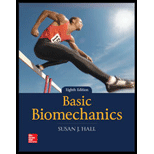
To determine: The velocities of the swimmer with respect to the current when the boy swims directly upstream and directly downstream.
Answer to Problem 1IP
The velocities of the swimmer with respect to the current when the boy swims directly upstream and directly downstream are 2 m/s in the upstream and 1 m/s in the downstream.
Explanation of Solution
Calculation:
The velocity of the swimmer with respect to the current when the boy swims directly upstream is,
Here,
Substitute
Thus, the velocity of the swimmer with respect to the current when the boy swims directly upstream is 2 m/s.
The velocity of the swimmer with respect to the current when the boy swims directly downstream is,
Here,
Substitute
Thus, the velocity of the swimmer with respect to the current when the boy swims directly downstream is 2 m/s.
Therefore, the velocities of the swimmer with respect to the current when the boy swims directly upstream and directly downstream are 2 m/s in the upstream and 1 m/s in the downstream.
Want to see more full solutions like this?
Chapter 15 Solutions
BASIC BIOMECHANICS
- a cat runs across a road that is 9 meters (m) wide. it covered this distance in 3 seconds (s). what is the speed of the car?arrow_forwardWhat can you determine from the following spirometery flow-volume loop?arrow_forwardTwo athletes, age 38, ran continuously for periods ranging from 60 to 165 min on a motor- driven treadmill at 255.7 m/min while confronted with an airflow equivalent to running speed in cool, moderate, and hot environments as part of their preparation for the Tokyo 2021 Olympic games . From the information given on Fig 2, which athlete, A or B, would be more likely to complete the marathon race? Use information from the graph to explain your answer. (4) 120 Athlete A 100 80 60 Athlete B 40 20- 12 24 36 48 60 72 Time (hours)arrow_forward
- When Galileo Galilei rolled a ball down an inclined plane, it traveled 2 meters in the first second, and a total of 8 meters in the first two With vo = 0, what was its acceleration on this inclined plane? 0 meter per second2 0 meters per second2 0 meters per second2 0 meters per second2 0 meters per second2arrow_forwardThe “mean-speed theorem” for finding average velocity under constant acceleration, proposed by the Oxford Calculators, and demonstrated geometrically by Nicole Oresme, is expressed algebraically as: density = weight/volume (m1)(v1) = (m2)(v2) (vm) = 1/2 (v0 + vf) s = (v0)(t) + 1/2 (a)(t2) velocity = distance/timearrow_forwardHow would you maintain the grossing station?arrow_forward
- The “mean-speed theorem” for calculating average velocity under constant acceleration, developed by Thomas Bradwardine and the Mertonian Calculators at Oxford University, is expressed algebraically as: density = weight/volume (m1)(v1) = (m2)(v2) C. (vm) = 1/2 (v0 + vf) s = (v0)(t) + 1/2 (a)(t2) velocity = distance/timearrow_forwardWrite a short dicussion based on the grapharrow_forward10) Suppose the fish could not keep pace with the highest speed tested and collapsed during the last minute of a 15-minute trial. Would the first 14 minutes be an accurate reflection of its metabolic swimming costs? Explain.arrow_forward
- The diffusional distance between the water and a capillary in the skin of a salamander is 1 μm. The Krogh’s diffusion coefficient is 25·10-6 nmol O2/sec·cm·mm Hg. Assume that the PO2 in salamander blood is 75 mm Hg, total atmospheric pressure is 760 mm Hg, water vapor pressure is 13 mm Hg, and α = 1.93 μmol O2/ml water·mm Hg. What is the rate of oxygen diffusion across a 1 cm2 patch of salamander skin? (Hint – you might not need all the data given. Start with Dalton’s Law and pay attention to units) (1 pt)arrow_forwardWhat is the relationship between Net force, mass and acceleration. Newton’s second law of motion?arrow_forwardIf a P-20 micropipettor is set at “110,” what volume of water will this measure? How much should that water weigh? If a P-1000 micropipettor is set at “035”, what volume of water will this measure? How much should that water weigh? Please include units in your answers!arrow_forward
- Basic Clinical Lab Competencies for Respiratory C...NursingISBN:9781285244662Author:WhitePublisher:Cengage
 Principles Of Radiographic Imaging: An Art And A ...Health & NutritionISBN:9781337711067Author:Richard R. Carlton, Arlene M. Adler, Vesna BalacPublisher:Cengage Learning
Principles Of Radiographic Imaging: An Art And A ...Health & NutritionISBN:9781337711067Author:Richard R. Carlton, Arlene M. Adler, Vesna BalacPublisher:Cengage Learning




